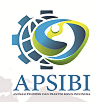Synchronous Learning with STEM and Economics Students’ Critical Thinking Abilities
Abstract
Increasing the quality of education has been a global challenge. The Indonesian government has responded this issue by reforming new curriculum that focuses on students’ activities and critical thinking ability. This study aims at investigating the implementation of synchronous learning with STEM and its impact to students’ critical thinking ability. This research adopted mixed methods, quasi-experimentally by using non-equivalent control group design research to gain a deeper understanding during experiment. The result of this work notes that synchronous learning with STEM slightly out performs the conventional learning activities and it can moderately illustrate the enhancing of students’ critical thinking skills. The introduction of STEM in social sciences, primarily in an economics course, faces some challenges and adjustments as well as its implementation using live synchronous learning This result suggests to more comprehensive planning and materials in adopting STEM in social sciences as well as an effort to increase students’ activities.
Keywords: Critical Thinking Skills, STEM Education, Economics Students, Synchronous Learning
Full Text:
PDFReferences
Akerson, V. L., Burgess, A., Gerber, A., Guo, M., Khan, T. A., & Newman, S. (2018). Disentangling the meaning of STEM: implications for science education and science teacher education. Journal of Science Teacher Education, 29(1), 1-8.
Bunyamin, M. A. H., Talib, C. A., Ahmad, N. J., Ibrahim, N. H., & Surif, J. (2020). Current Teaching Practice of Physics Teachers and Implication for Integrated Stem Education. Universal Journal of Educational Research, 8(5A), 18-28.
Capraro, R. M., & Slough, S. W. (2013). Why PBL? Why STEM? Why now? An introduction to STEM project-based learning: An integrated science, technology, engineering, and mathematics (STEM) approach. In STEM project-based learning (pp. 1-5). Brill Sense.
Cottrell, S. (2017). Critical thinking skills: Effective analysis, argument and reflection. Macmillan International Higher Education.
Doleck, T., Bazelais, P., Lemay, D. J., Saxena, A., & Basnet, R. B. (2017). Algorithmic thinking, cooperativity, creativity, critical thinking, and problem solving: exploring the relationship between computational thinking skills and academic performance. Journal of Computers in Education, 4(4), 355-369.
Dwyer, C. P. (2017). Critical thinking: Conceptual perspectives and practical guidelines. Cambridge University Press.
Firdaus, F., Kailani, I., Bakar, M. N. B., & Bakry, B. (2015). Developing critical thinking skills of students in mathematics learning. Journal of Education and Learning, 9(3), 226-236.
Hafni, R. N., Herman, T., & Mustikasari, E. N. L. (2020). The importance of science, technology, engineering, and mathematics (STEM) education to enhance students’ critical thinking skill in facing the industry 4.0. In Journal of Physics: Conference Series (Vol. 1521, p. 042040).
Hue, L. T., Tuyet, V. T., & Ninh, T. T. (2020). Developing the Ability to Apply Knowledge and Skills for Students under Stem Education. American Journal of Educational Research, 8(5), 340-346.
Khalil, N., & Osman, K. (2017). STEM-21CS module: Fostering 21st century skills through integrated STEM. K-12 STEM Education, 3(3), 225-233.
Krajcik, J., & Delen, I. (2017). How to support learners in developing usable and lasting knowledge of STEM. International Journal of Education in Mathematics, Science and Technology, 5(1), 21-28.
Martin‐Paez, T., Aguilera, D., Perales‐Palacios, F. J., & Vílchez‐González, J. M. (2019). What are we talking about when we talk about STEM education? A review of literature. Science Education, 103(4), 799-822.
Mater, N. R., Haj Hussein, M. J., Salha, S. H., Draidi, F. R., Shaqour, A. Z., Qatanani, N., & Affouneh, S. (2020). The effect of the integration of STEM on critical thinking and technology acceptance model. Educational Studies, 1-17.
Mutakinati, L., Anwari, I., & Kumano, Y. (2018). Analysis of students’ critical thinking skill of middle school through stem education project-based learning. Jurnal Pendidikan IPA Indonesia, 7(1), 54-65.
Nowak, A. Z., & Dahal, G. (2016). The contribution of education to economic growth: Evidence from Nepal. International Journal of Economic Sciences, 5(2), 22-41.
Sagala, R., Umam, R., Thahir, A., Saregar, A., & Wardani, I. (2019). The Effectiveness of STEM-Based on Gender Differences: The Impact of Physics Concept Understanding. European Journal of Educational Research, 8(3), 753-761.
Sari, Y. S., Selisne, M., & Ramli, R. (2019, April). Role of students’ worksheet in STEM approach to achieve competence of physics learning. In Journal of Physics: Conference Series (Vol. 1185, No. 1, p. 012096). IOP Publishing.
Saviotti, P. P., Pyka, A., & Jun, B. (2016). Education, structural change and economic development. Structural Change and Economic Dynamics, 38, 55-68.
Shahali, E. H. M., Halim, L., Rasul, M. S., Osman, K., & Zulkifeli, M. A. (2016). STEM learning through engineering design: Impact on middle secondary students’ interest towards STEM. EURASIA Journal of Mathematics, Science and Technology Education, 13(5), 1189-1211.
Siregar, Y. E. Y., Rachmadtullah, R., Pohan, N., & Zulela, M. S. (2019, March). The impacts of science, technology, engineering, and mathematics (STEM) on critical thinking in elementary school. In Journal of Physics: Conference Series (Vol. 1175, No. 1, p. 012156). IOP Publishing.
Thibaut, L., Ceuppens, S., De Loof, H., De Meester, J., Goovaerts, L., Struyf, A., ... & Hellinckx, L. (2018). Integrated STEM education: A systematic review of instructional practices in secondary education. European Journal of STEM Education, 3(1), 2.
Voordijk, H. (2009). Construction management and economics: the epistemology of a multidisciplinary design science. Construction management and economics, 27(8), 713-720.
Wu, S. P., & Rau, M. A. (2019). How students learn content in science, technology, engineering, and mathematics (STEM) through drawing activities. Educational Psychology Review, 31(1), 87-120.
Refbacks
- There are currently no refbacks.
JPBM (Jurnal Pendidikan dan Bisnis Manajemen) is licensed under a Creative Commons Attribution-NonCommercial-ShareAlike 4.0 International License.
JPBM (Jurnal Pendidikan dan Bisnis Manajemen) is abstracted and indexed in :
















